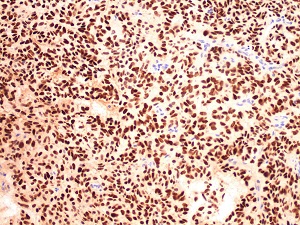
T-Pit (clone CL6251) by IHC-12376 - Technical only, 12379 - Technical & interpretation
Test info
LAB12379
- All IHC stains will include a positive control tissue
T-Pit is used in conjunction with SF-1 and Pit-1 immunohistochemical stains to classify pituitary adenomas. The presence of T-Pit nuclear reactivity within a monomorphous population of neuroendocrine cells within the sella turcica strongly supports adrenocorticotropin lineage. T-Pit is considered to be more sensitive and specific than ACTH IHC6.
Specimen
Submit a formalin-fixed, paraffin embedded tissue block
Formalin-fixed, paraffin embedded (FFPE) tissue block
FFPE tissue section mounted on a charged, unstained slide
Ambient (preferred)
- Unlabeled/mislabeled block
- Insufficient tissue
- Slides broken beyond repair
Performance
Immunohistochemical staining and microscopic examination
Clinical and Interpretive info
If requested, an interpretive report will be provided
Specifications
T-Pit (T-box family member TBX19) regulates the proopiomelanocortin (POMC) lineage giving origin to corticotrophs
Staining pattern
- Nuclear staining
- Normal adenohypophysis shows T-Pit positivity in scattered cells and cell clusters
- Positive in pituitary adenomas of adrenocorticotropin lineage
References
- Asa SL. Practical pituitary pathology: what does the pathologist need to know? Arch Pathol Lab Med. 2008;132(8):1231-40.
- Asa S. Tumors of the Pituitary Gland. Silverberg SG, editor. Washington, DC: American Registry of Pathology; 2011. 283 p.
- Mete O, Cintosun A, Pressman I, Asa SL. Epidemiology and biomarker profile of pituitary adenohypophysial tumors. Mod Pathol. 2018;12(10):018-0016.
- Lamolet B, Pulichino AM, Lamonerie T, Gauthier Y, Brue T, Enjalbert A, et al. A pituitary cell-restricted T box factor, Tpit, activates POMC transcription in cooperation with Pitx homeoproteins. Cell. 2001;104(6):849-59.
- Pulichino AM, Vallette-Kasic S, Couture C, Gauthier Y, Brue T, David M, et al. Human and mouse TPIT gene mutations cause early onset pituitary ACTH deficiency. Genes Dev. 2003;17(6):711-6.
- Sjostedt E, Bollerslev J, Mulder J, Lindskog C, Ponten F, Casar-Borota O. A specific antibody to detect transcription factor T-Pit: a reliable marker of corticotroph cell differentiation and a tool to improve the classification of pituitary neuroendocrine tumours. Acta Neuropathol. 2017;134(4):675-7. doi: 10.1007/s00401-017-1768-9. Epub 2017 Aug 19.
- McDonald WC, Banerji N, McDonald KN, Ho B, Macias V, Kajdacsy-Balla A. Steroidogenic Factor 1, Pit-1, and Adrenocorticotropic Hormone: A Rational Starting Place for the Immunohistochemical Characterization of Pituitary Adenoma. Arch Pathol Lab Med. 2017;141(1):104-12.
Billing
88341 - each additional stain
